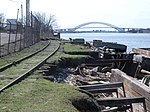West New Brighton station
1886 establishments in New York (state)1953 disestablishments in New York (state)North Shore Branch stationsRailway stations closed in 1953Railway stations in the United States opened in 1886 ... and 2 more
Use mdy dates from December 2017West New Brighton, Staten Island

West New Brighton, also referred to as West Brighton, is a station on the abandoned North Shore Branch of the Staten Island Railway. It had two side platforms and two tracks. It was located at-grade in the West New Brighton section of Staten Island, north of Richmond Terrace between North Burgher Avenue and Broadway. The station site is 2.4 miles (3.9 km) from the Saint George terminus. No trace of the station exists today.
Excerpt from the Wikipedia article West New Brighton station (License: CC BY-SA 3.0, Authors, Images).West New Brighton station
Richmond Terrace, New York Staten Island
Geographical coordinates (GPS) Address Nearby Places Show on map
Geographical coordinates (GPS)
| Latitude | Longitude |
|---|---|
| N 40.6415 ° | E -74.1173 ° |
Address
Richmond Terrace 1449
10310 New York, Staten Island
New York, United States
Open on Google Maps










